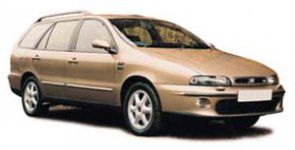Tests to Carry Out
Engine checks
On all engines, make sure the the cam belt was changed at 72,000 miles, if the car has reached that figure. Some independent Fiat specialists recommend changing the belt at 40,000, just in case so after purchase, make sure you get the belt changed sooner rather than later.
Locate the radiator expansion tank. It's at the side of the engine compartment in front of the driver on early cars; on post-99 cars it's right at the front, ahead of the passenger. Make a note of the fluid level, you'll need to recheck it later.
On more expensive models, check the leather steering wheel trim, and only buy if the amount of wear seems to match the claimed mileage.
Warning lights
ABS brakes are standard on the more powerful models, optional on the rest. Switch the ignition on and look for the amber ABS light at the right hand end of the row of warning lights. If it comes on, it should go out again almost immediately. If it comes on later when you're driving, the ABS system is faulty and it's safest to reject the car.
If a red warning light with an exclamation mark comes on at the same time as the ABS light, do not drive the car and certainly don't buy it; the electronic braking device is probably faulty.
Finally, look for the red fuel injection light in the left middle of the row. If it comes on and stays on, the fuel injection system is in get-you-home mode and the car should only be driven for short distances. Don't buy; the exhaust catalyst probably needs replacing and there may be an expensive fault with the injection system as well.
Road test
You'll probably find the seat and driving position very comfortable. Both were designed at the University of Loughborough, and even drivers with bad backs usually find them acceptable.
Although firm suspension helps roadholding and handling, it does produce a busy, noisy ride. If comfort is a high priority, Bravo isn't for you.
On a bumpy bit of road, listen for rattles from the front of the car. These are quite common on early cars and are caused by wear in the anti-roll links. Budget £70 per side to get them replaced.
Listen also for interior rattles and squeaks especially on early cars, although not all models suffer equally. The Brava tends to be particularly bad for random noises. If need be, try several cars and see if you can find one that drives reasonably quietly. Revised 1999 models are better, while careful DIY work can quieten an early car as well.
Check the audio
Bravo has an integral radio/cassette player in the upper dashboard. It¹s an elaborate set-up and the unusual cassette flap is fairly fragile. Ask the seller to demonstrate that the system works and check that the cassette flap retracts properly. A replacement audio from Fiat costs around £260; though you can fit a non-Fiat one for less. Top models have audio controls on the steering wheel; check they work correctly.
Warm engine checks
You need a test drive of at least 10 miles to get the engine really warm. If the car drives well and you're considering buying, lift the bonnet to check the fluid level in the expansion tank when you get back to base. Then re-start the engine and leave it running with the bonnet shut, until you hear the whoosh of the radiator fan coming on.
If the engine boils before the fan comes on, or the fluid level has fallen while you are out, don't buy. The engine has probably overheated at some time and the head gasket has probably failed already — an expensive fault. Looking round the bodywork Consider the colour there are some weird and wonderful shades available, especially the fashionable off-beat metallic colours on Bravo/Brava. If you fancy one of these, do remember that a car in last year¹s colour may be hard to shift in the future.
Check carefully for dull paintwork and crash damage. Modern Fiat paintwork is very good, so any sign of body damage or paint deterioration means rejecting the car. And take a close look at the large, vulnerable bumpers.
On the Marea Weekend, the centre section of the rear bumper folds down to give better access to the luggage area. Check it folds down easily as it's vulnerable to crash damage. Check the luggage area carefully as well particularly on diesels, which may have been used for long distance courier work or similar. The luggage bay trim does not stand up very well to this sort of use and the luggage cover is not very robust either.


